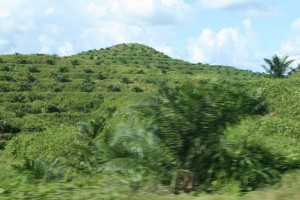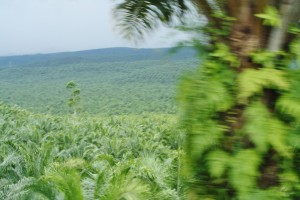For a long time already Borneo has ceded to be this innocent island full of rainforest, wildlife and paradise beaches that it tries to sell to package tourists.  The issues here are manyfold, but besides waste disposal (people don’t even burn the plastic waste, it’s scattered at road sides, on beaches and even on reefs across Sabah), deforestation is the one you certainly cannot escape from. Logging has been a main issue in the history of Borneo for almost 150 years. Already in 1878 the British North Borneo Company leased the area that is now Sabah from the Sultan of Sulu to exploit the dense forests. Today, the main reason for clearing ever more of the little remaining rainforest is palm oil. Traditionally used for frying and in soap production, the Americans used it to produce Napalm. These days, the growing global demand for palm oil is driven by its use as a raw product for biofuel.
The issues here are manyfold, but besides waste disposal (people don’t even burn the plastic waste, it’s scattered at road sides, on beaches and even on reefs across Sabah), deforestation is the one you certainly cannot escape from. Logging has been a main issue in the history of Borneo for almost 150 years. Already in 1878 the British North Borneo Company leased the area that is now Sabah from the Sultan of Sulu to exploit the dense forests. Today, the main reason for clearing ever more of the little remaining rainforest is palm oil. Traditionally used for frying and in soap production, the Americans used it to produce Napalm. These days, the growing global demand for palm oil is driven by its use as a raw product for biofuel.
Yes, palm oil-based biofuel is renewable (as opposed to fossil enery sources) and in that respect sustainable, and it’s certainly labeled as ‚green‘ wherever sold in the West. However, the destruction that has taken place to make way for palm oil plantations is beyond belief. If you look down from the slopes of Mount Kinabalu (Malaysia’s highest peak) to the east, palm trees are the only thing you see – all the way to the horizon. Wildlife such as the unique Borneo proboscis monkey, Orang Utans, elephants, crocodiles and so on has been squeezed into the few and small remaining nature reserves, while the rest of the province is now covered with palm oil plantations of various different shapes and ages. It is a monoculture that doesn’t leave space for much other fauna or flora. So much for biodiversity… The contribution of this destruction of rainforest to global warming is yet to be determined, but expected by experts to exceed many other factors that receive much more public attention.
To increase the yield, the floors of the plantations are widely treated with pesticides as well as fertilizers, which the monsoon rain in turn flushes into the ground water, the nature reserves and the mangrove forests on the coast. It is hard not to be shocked by the extent of this man-made remodeling of nature.
On the other hand it is difficult to complain and not be a hypocrit if you come from a western country where agricultural needs have dominated and destroyed natural landscapes for hundreds of years.  The areas that are now fields of rapeseed (much of which is processed into biodiesel which competes with the palm oil-based fuels on the international markets) across Europe have at some point hosted long displaced wildlife such as bears or wolves.
The areas that are now fields of rapeseed (much of which is processed into biodiesel which competes with the palm oil-based fuels on the international markets) across Europe have at some point hosted long displaced wildlife such as bears or wolves.
In Malaysian Borneo palm oil isn’t seen as a problem, but as a solution. It is an industry that employs half a million people across the country and helps people in remote areas out of poverty.
So the biofuel seems to have won its battle against the rain forest. But with most of the plantations growing palm trees for land-inefficient first generation biofuels, the positive impact for the environment unfortunately remains very limited. It’s just not as easy as replacing green rainforest with ‚green‘ biofuel.
But the deed is already done, the forests are gone for the most part, and the global market is craving more renewable fuels. So we’ll visit the pockets of remaining rainforest here to see the wildlife seeking refuge there – sadly we might not have the chance to do so in the future.



One Response to Biofuel versus rain forest